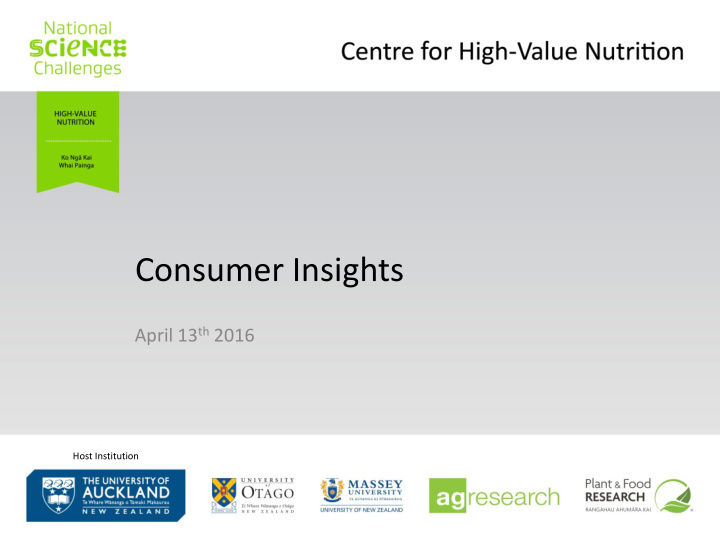



Consumer Insights April 13 th 2016 Host Institution
Introduction • Team: Roger Harker, Sara Jaeger, Denise Conroy, Phil Bremer, Bill Kaye-Blake • Project 1: Background literature and existing insights within NZ business and research organisations provide early guidance. • HVN aligned projects – Example: Plant & Food Research project on consumer insights from China.
Conversations with Chinese consumers about the role of eating and drinking in their lives The New Zealand Institute for Plant & Food Research Limited
Interview setting in participants’ home with video and audio recording and simultaneous translation The New Zealand Institute for Plant & Food Research Limited
Interview setting in participants’ home with video and audio recording and simultaneous translation The New Zealand Institute for Plant & Food Research Limited
A typical day in the life of a Chinese consumer The New Zealand Institute for Plant & Food Research Limited
A typical day in the life of a Chinese consumer The New Zealand Institute for Plant & Food Research Limited
A typical day in the life of a Chinese consumer The New Zealand Institute for Plant & Food Research Limited
A typical day in the life of a Chinese consumer The New Zealand Institute for Plant & Food Research Limited
“Nobody buys Chinese milk. We don’t trust it” The New Zealand Institute for Plant & Food Research Limited
“At hypermarket I trust meat to not be injected. At wet market, I’m not so sure and it is unhygienic.” The New Zealand Institute for Plant & Food Research Limited
“Bread in shops are full of preservatives. I bake my own. It is easy and good for my health.” The New Zealand Institute for Plant & Food Research Limited
“It is more expensive, but I only buy GM-free cooking oil. It is safer. I saw that on TV.” The New Zealand Institute for Plant & Food Research Limited
“I do eat well, but my friends started with multi-vitamins. They made me try. I use them now.” The New Zealand Institute for Plant & Food Research Limited
SOCIETAL VALUES Food Government Culture CONSUMER FOOD CHOICE Food Business Environment Culture The New Zealand Institute for Plant & Food Research Limited
Chinese consumers share many similarities with consumers elsewhere, and express differences embedded in local context (past and present) The New Zealand Institute for Plant & Food Research Limited
Health and wellness beliefs in food » Chinese people often classify food into heaty (yang) and cooling (yin) categories A balanced diet of “yin” and “yang” is » believed to help stabilize and promote healthy function of the body » The intake of heaty and cooling foods are important for both prevention and cure of disease. “Lamb is too heaty for summer; your “The bitter ulcer will get “Don’t eat more vegetables are worse.” than three good in summer crabs; it’s too to kill your cooling, you’ll inner fire.” get diarrhoea.” The New Zealand Institute for Plant & Food Research Limited
Health and wellness beliefs in food Heaty (yang) food examples Cooling (yin) food examples The New Zealand Institute for Plant & Food Research Limited
Health and wellness beliefs in food Heaty (yang) food examples Cooling (yin) food examples Excessive “cold” energy Too much heaty foods may result in feelings of in the body may result in irritability, short temper, feeling weak, lethargic, fever, constipation, sore tired and restless. throat, nose bleed, outbreak of pimples and acne, mouth ulcers and indigestion. The New Zealand Institute for Plant & Food Research Limited
“Too much inner heat can last for days. My throat is sore and I drink TCM tea to feel better. ” The New Zealand Institute for Plant & Food Research Limited
Health tea menu in domestic airport terminal The New Zealand Institute for Plant & Food Research Limited
“People seek longevity now. If you are not healthy, you Conclusions for HVN need to pay a lot of money to go see doctors and it is not affordable for a normal • Health is one of the most family (and that’s why health is the most important factors when important thing when it choosing foods. comes to food).” • Rich traditional wisdom combined with new trends are shaping / reshaping consumers’ views on health. • We need appropriate communication strategies. • We need to be aware of the overall food environment
Recommend
More recommend